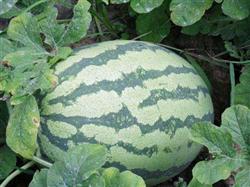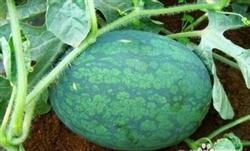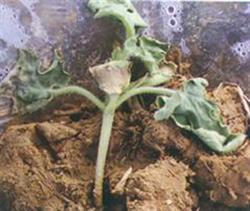Control of watermelon and stiff melon in spring

The causes of stiff melons are as follows: 1. Dry soil, lack of fertilizer and water: if the fruit expansion period, if the lack of fertilizer and water, it is easy to form stiff fruit. Therefore, the melon land should be irrigated, and the amount of water should be irrigated from less to more. The retention time of water in the field should not be too long. It should be irrigated in the evening or at night to avoid burning roots at high temperature. In order to develop watermelon in hilly land, the water storage capacity should be increased before winter, and the method of seedling raising and transplanting should be adopted to strive for early fruit setting so as to reduce the effect of drought on fruit expansion. When the young fruit grows to the size of the egg, chase the melon fertilizer in time. two。 Lack of functional leaves: generally speaking, fruits with more leaves grow larger and of good quality, so there should be a considerable number of functional leaves for light and function in cultivation to meet the needs of fruit expansion. 3. Melon vine growth is too prosperous: the production of nutrient stem, leaf growth consumption, can not meet the needs of fruit expansion, and shows a state of crazy growth. Strong seedlings should be cultivated to lay a good foundation for normal fruit development. before and after fruit setting, the application amount and time of expanded melon fertilizer should be adjusted according to the size of new leaves, the thickness of vines, the length of internodes, and the length from the top of the vine to the node of open female flowers. If the length from the top of the vine to the node of the open female flower is more than 67 cm, it means that the melon vine is overgrowing and should be restrained; if its length is less than 50 cm, it means that the melon vine is weak and should be fertilized immediately to promote its growth; if its length is within the range of 50-67 cm, it means that the melon vine is growing normally. 4. During pollination, the amount of pollen from male flowers applied to the stigma of female flowers is insufficient, and the number of seeds has an important effect on the development of fruit. Under the same conditions, the fruit with more seeds grows bigger. Therefore, it is necessary to choose the best time to put as much viable pollen on the stigma as possible, so as to increase the number of seeds and achieve the goal of high yield. 5. Female flowers are slender and thin, and flowers with sparse hairs are not easy to set fruit after pollination, and it is difficult to grow even if they set fruit. Therefore, female flowers with well-developed buds, large and exuberant growth should be selected for pollination. The main characteristics of high-quality female flowers are thick stalk, large ovary, normal appearance, bright green and glossy color, and dense pilose. 6. The leaves seriously damaged by diseases and insect pests can not carry out photosynthesis normally and affect the fruit development. 7. If the fruit is too close or too far away, the expansion of the fruit will be affected by many aspects.
- Prev

Causes and control measures of watermelon and stiff melon in spring
1. Excessively growing melon vines: the production of nutrient stems and leaves consume a lot of growth, which can not meet the needs of fruit expansion, but show a state of crazy growth. Strong seedlings should be cultivated to lay a good foundation for normal fruit development. Before and after fruit setting, according to the size of new leaves, the thickness of vines, the length of internodes, and from the top of the vine to already opened.
- Next

Solving measures for abnormal seedlings of watermelon and muskmelon in spring
The main results are as follows: 1. The uneven emergence of seedlings is mainly caused by the uneven ground temperature and humidity of the seedling bed. When laying a ground hot line, the wiring spacing at the front of the greenhouse is 3 cm 4 cm, and the distance along the back of the greenhouse is 7 cm 8 cm, so as to make the bed temperature uniform; when large and small seedlings appear, move the big seedlings to the lower temperature at the front of the greenhouse to make the young.
Related
- Moge, come on! The staff of the peasant association in the producing area of cantaloupe were frightened when the crowd gathered.
- Causes and Solutions of low Fruit setting rate of Apple
- Symptoms and control measures of passion fruit virus disease
- Fruit growing lesson: how do apple orchards keep high yields?
- Can you build orchards in the mountains? What are the pros and cons?
- How to manage the coloring period of Crisson grape?
- This paper introduces the processing technology of two kinds of fig products.
- How much is a month for retired teachers in rural areas by 2020?
- How can strawberry planting increase sugar content? We should pay attention to management in many aspects.
- What are the cultivation techniques on how to improve the yield of golden fruit?

